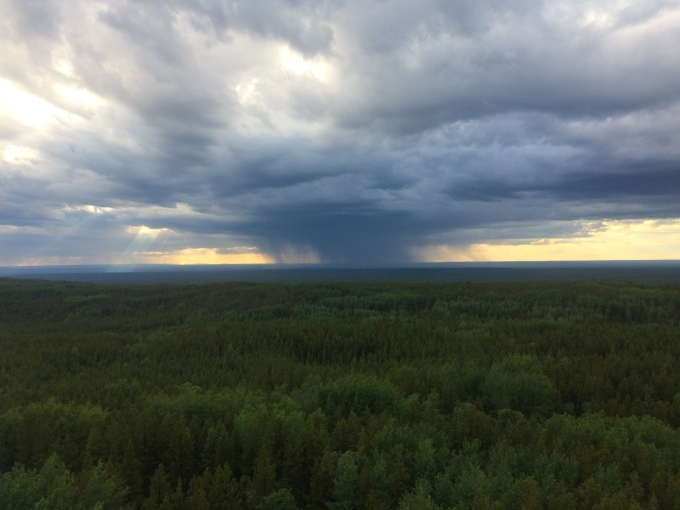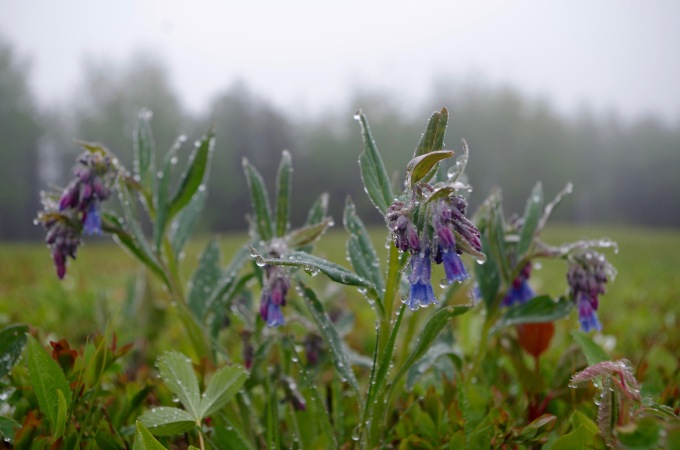Riding the Highs and Lows on the Lookout Tower
I’ll admit it. I’ve lost track of time. I can give you an up-to-the-minute weather report. I can tell you if it’s a burning day, or not. But, as I write this, I’m not sure if it’s Tuesday, or Wednesday. And I can’t tell you how long I’ve been out here. That may sound crazy, but let me assure you: the concept of ‘time’ changes when you’re a lookout observer at a remote fire tower. The hours, days, and weeks expand like beans boiling on the stovetop. You start tracking and measuring the days by watching the carrots in your garden grow, noticing when the wild strawberries blossom and fruit, and recalling the rare days you witnessed something surreal: a grizzly bear, a wicked lightning storm, or better yet – a wildfire.

It’s a good thing I keep excellent records. I take down my tower calendar, flip back a month, and trace my finger to May 8th, where I penciled in TOWER OPENING, marking the date the helicopter dropped me off at my fire tower in the Peace Country. I tally up the days. Every day on the calendar contains a letter I scribbled in to denote our “cupola occupancy level” (the minimum number of hours we’re expected to spend up in the tower, scanning for smoke) for the day: L is for low hazard, H for high, E for extreme. On low days, lookouts climb the tower every two hours to do the ritual 360-scan. On high and extreme days, we’re confined to the cupola – our office in the sky – from 9 a.m. to 8 p.m., eyes glued to storm cells, searching for the quick flash of lightning, and the faint curl of smoke. For a lookout, both kinds of days have their own sets of challenges and rewards.
My fingers track left to right on the calendar, counting the days spent on high and low, summarizing the pattern of the 2017 fire season in the Peace Country, thus far.

Low, low, low, low, low. I shiver, remembering our first long stint in early May with cold temperatures, persistent drizzle, and being trapped in the cabin by thick fog – zero visibility. Being fogged in gave me too much time to think about how “civilization-sick” I felt. I missed my friends. I craved the freedom of going somewhere, anywhere, even if it was to the grocery store. “How can I be feeling this way so early on in the season?” I fretted aloud to my dog, Holly, after our fourth day with cabin fever, busying myself with hand scrubbing a pair of socks in the kitchen sink.
But before I knew it, the sun was back, beating down on us with higher than usual temperatures for mid-May. Back up to the cupola I climbed to spend 11-hour days looking for smoke while watching the aspen buds open and fill up the forest mosaic with patches of bright green. High, high, extreme, extreme, extreme. Over the May long weekend, these hot, dry days finally succumbed to the frigid airs that blew in from the northwest and dumped 5 cm of snow over the tower. While icicles dangled off the tower – too dangerous to make a climb – I cranked the propane furnace in my cabin, drank liters of hot chocolate, and devoured 3 books in 4 days until the sun licked away the snow.

In mid to late May, the temperatures soared and stayed at a hot stalemate for 12-days straight. Lookouts in the Peace Country started a marathon stint on high and extreme – 132 hours up in the sky. No storm cells. No lightning. Nothing but blue skies, harmless cumulus tufts, and winds racing through the forest. I roasted in the cupola under the sun, while boredom sank its teeth into me. I watched like a hawk and waited, waited to spy the slightest sign of smoke, the softest smudge of bluish-grey, or white, on a 40-km radius of forest that’s become familiar to me as the back of my hand.
Finally, it happened. FIRE DAY!!! I scribbled in blue ink beside June 1st on the calendar.
I remember the afternoon perfectly. At last, the cumulonimbus clouds rolled in from the west. I spied my first strike just before delivering my PM weather report. The cell tracked across my north, heading 50 km east towards my neighbour’s tower. Suddenly, I could hear my neighbour’s voice over the radio, calling in dry strikes (lightning strikes without precipitation). The initial attack crew (HAC2) below – day-basing at my tower– stirred, anticipating a dispatch. The pilot paced like a panther, hollering up, “See anything?” I could see plenty: a spectacular blue storm streaked with white, evident of the hail pounding down on the ridge, and the faintest sign of a rainbow through the mist. But no smokes. It seemed like nothing would happen. By five o’clock, I was convinced as much, and exactly at the moment my disbelief sunk in, I looked up and saw blackish smoke rising up out of a distant ridge, 30 kilometers away. Heart in throat, I picked up my radio and called it in my bearing and distance. It turned out to be a “one pile wonder”, a timber pile in the middle of a huge clearing, lit up by a dry lightning strike. Peace Wildfire 031, lightning caused, 0.1 hectares – I scribbled on the calendar. A momentous occasion – and a new reference point for sorting out my timeline at the tower.

Such is life on the lookout in the boreal. The weather cycles through hot-dry to cold-wet conditions. Some areas of the forest burn, while other parts build and grow. The lookout self-regulates according to the weather and fire conditions, moving up and down the ladder like a yo-yo. We listen to the weather reports, receive our occupancy levels every evening at 7 o’clock ‘sked’ (daily radio check-in with the Fire Centre), but it’s impossible to truly predict what will happen tomorrow.
Yesterday, I woke at 6 am to a murderous clap of thunder overtop my cabin. I stumbled out into the eerie dark violet light, lay down amongst the wildflowers, and watched with equal parts terror and awe, bolts of lightning zipper through the sky behind the tower, forking and striking with overwhelming intensity. My day in the sky lasted from 10 a.m. until 10 p.m. I called in a smoke –40 km to my northwest, by the late afternoon, while a total of seven wildfires broke out in the Peace Country. It was a wild, memorable day on the watch. I climbed down, my eyelids feeling like sandbags; hungry, dehydrated and exhausted.

But today, as I type, the world outside has transformed. It’s a Romeo-Whisky kind of day; lookout code for ‘rain showers’, meaning it’s the kind of day I don’t have to worry about lightning, or smokes. Today, I’ll drink coffee, read, bake a loaf of sourdough, sculpt a mug from clay, write this article, cuddle with the dog, and likely dance around the kitchen floor in wool socks.
People ask what kind day I prefer – to be on high hazard, or low hazard. I know now that I couldn’t possibly endure a summer with one and not the other. Just as the boreal requires rain and fire to grow and regenerate, the lookout observer needs a balance of being up in the sky and with two feet on the ground to mentally, physically, and emotionally survive a fire season.

When I add up the days, I’ve been at the tower for nearly two months, but it feels like oh-so-much-longer than that. Time can feel eternal out here. On the other hand, a wildfire can ignite in a fraction of a second. If there’s anything I’ve learned, it’s that being a lookout requires you to endure extreme paradoxes – high/low, excitement/boredom, joy/loneliness, and fire/rain. The key to survival out here is learning how to weather whatever weather Mother Nature throws at you. To be ready for anything to happen and nothing to happen, all at once.
And to always take the time to smell the wildflowers.
-Trina

1 Comment
Great story, Treen! So much feeling! This sounds like the beginning of a book? Marj